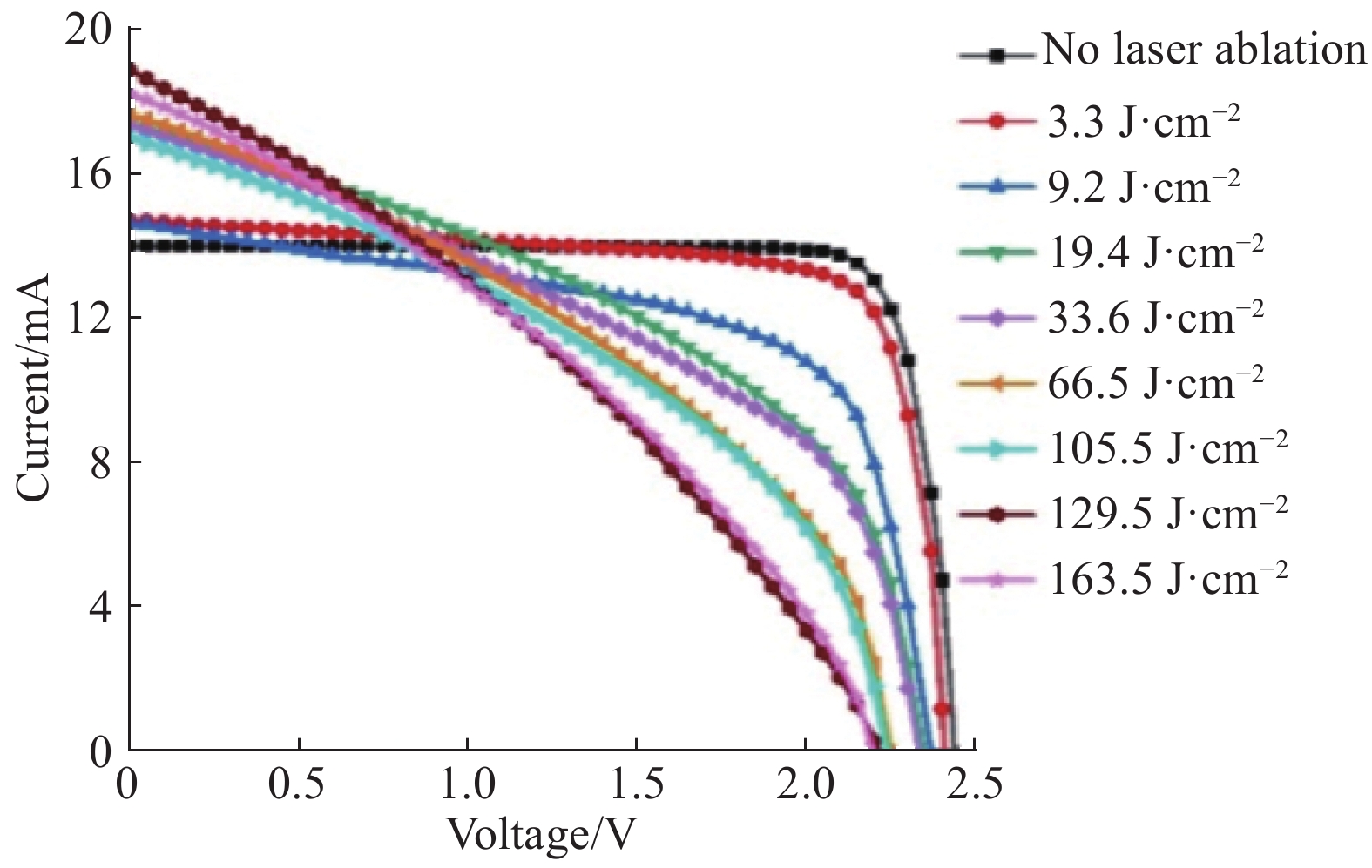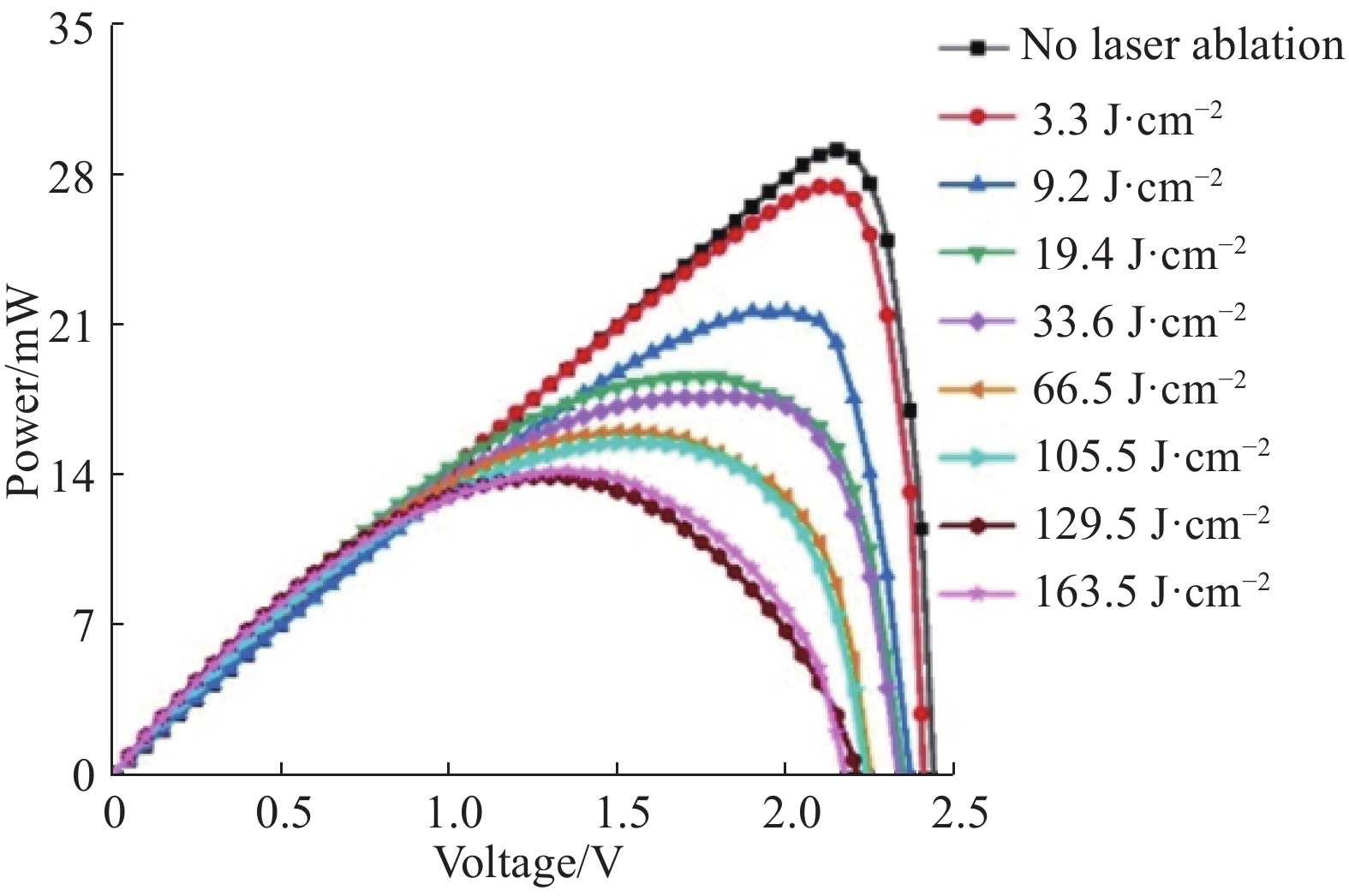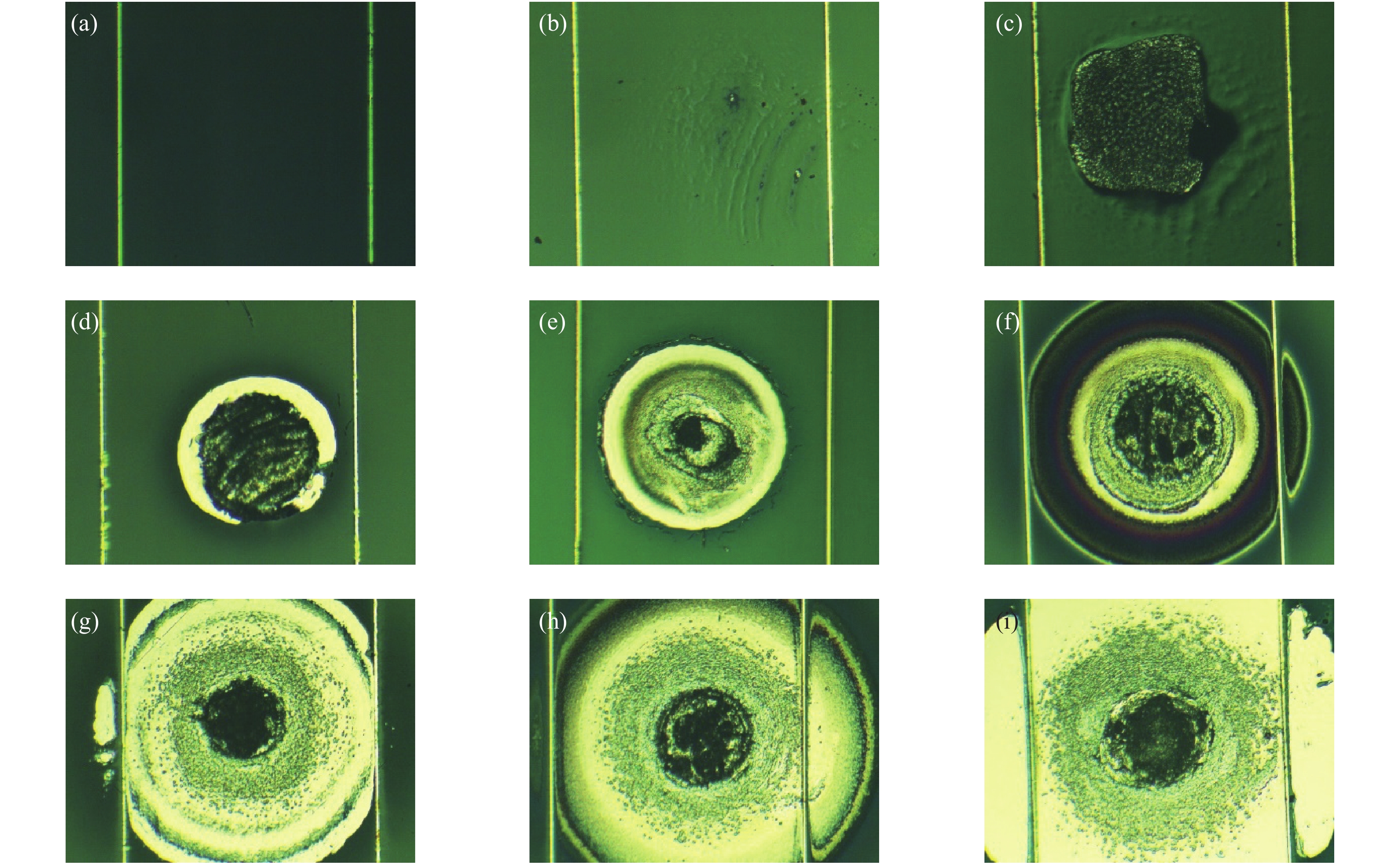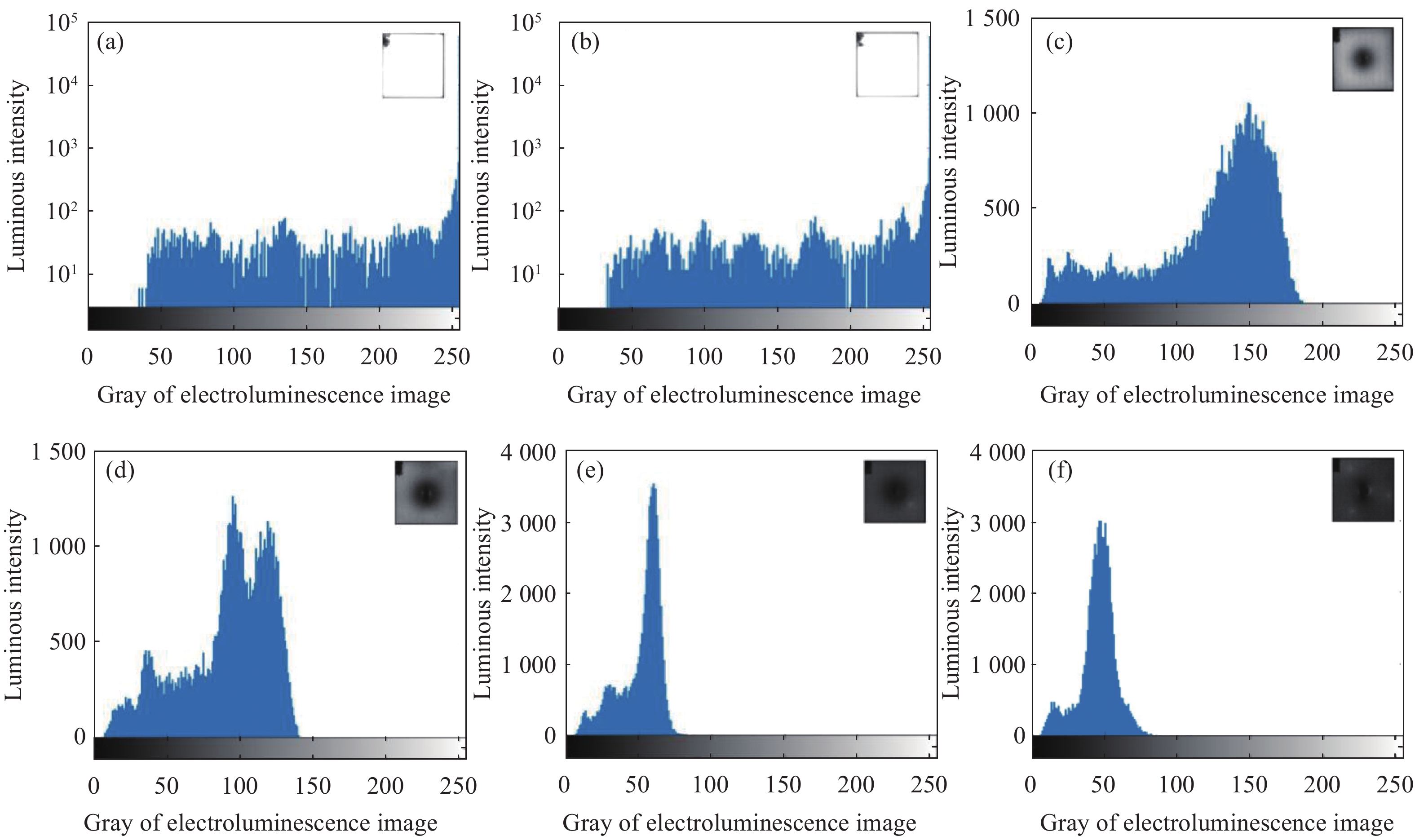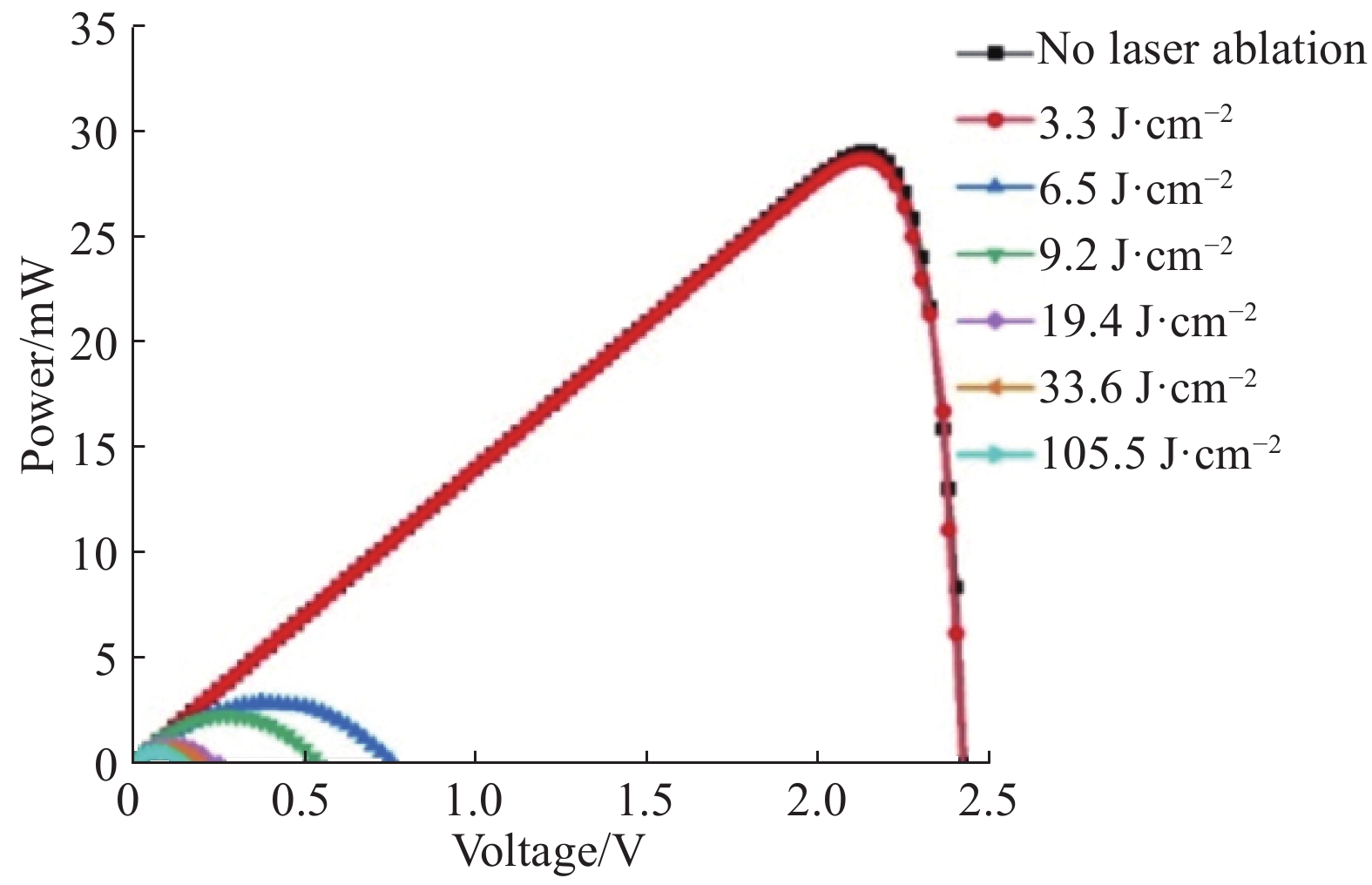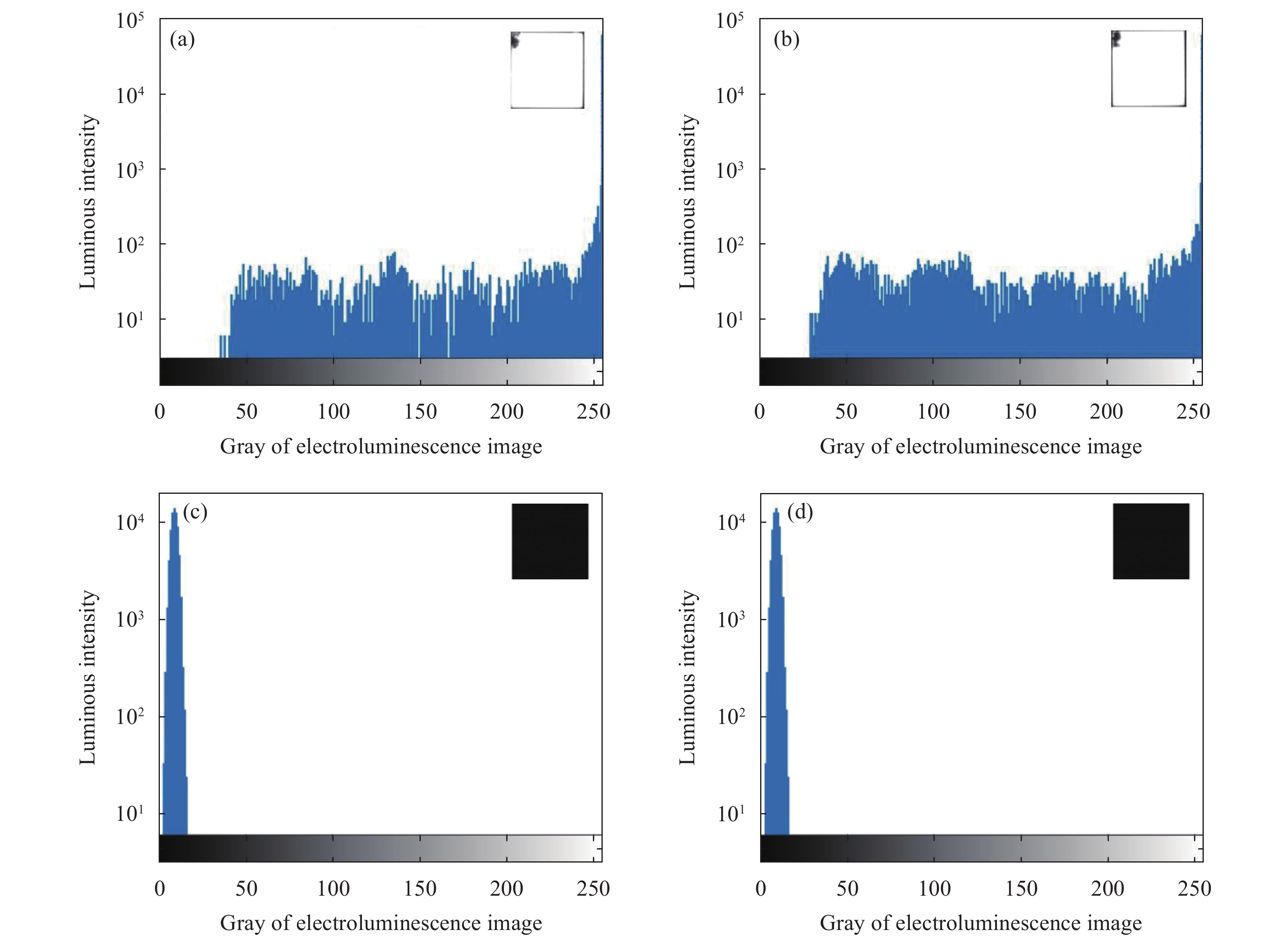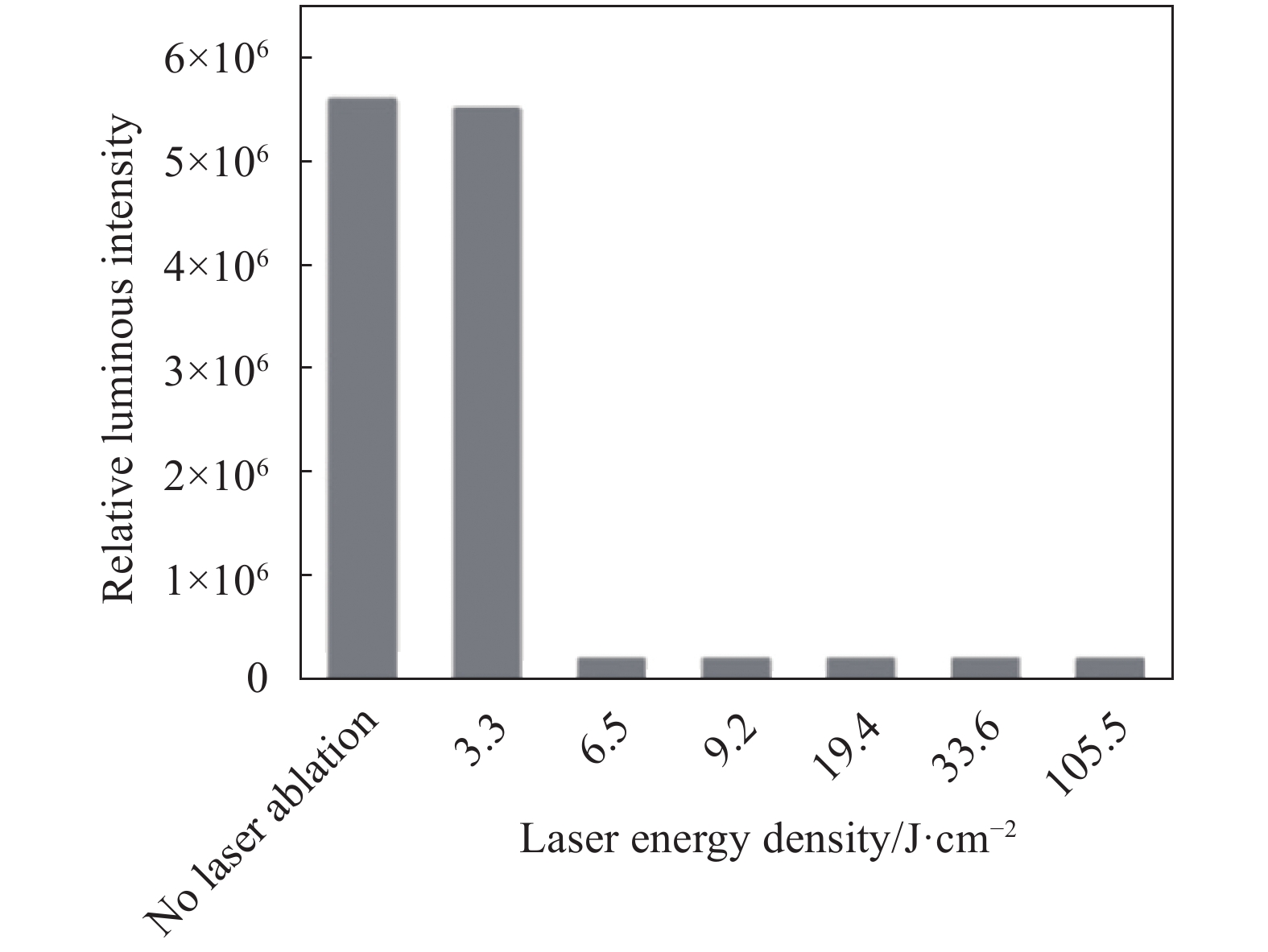-
太阳能电池作为航天器电能的重要来源,在空间中已广泛使用。到目前为止,太阳能电池在空间中的使用占比达到了90%[1]。自1954年首次发现GaAs材料具有光电效应以来,在继硅、锗太阳能电池之后,目前已发展到第三代半导体GaAs太阳能电池[2-4]。相比较硅太阳能电池,GaAs电池具有更高的光电转换效率,并且在耐高温、抗辐射等方面都具有更好的性能[5-7],广泛运用在空间气象探测、遥感、导航等卫星上。
激光作为一种高亮度光源,辐照太阳能电池时会对电池光电特性产生影响,当激光能量密度足够高时,极易引起电池损伤。Iwata等[8]研究了纳秒脉冲激光辐照对GaAs材料表面的损伤,实验中使用一束He-Ne激光作为探测光辐照硅表面,通过测量激光束的反射强度来表征材料表面的损伤程度,实验发现纳秒脉冲激光对GaAs材料的损伤阈值相对较低。Li等[9]研究了连续激光在大气环境下辐照GaAs太阳能电池产生的影响,当激光功率密度为507 W/cm2,辐照时间17 s后,电池开路电压、短路电流、最大功率分别下降为辐照前的81.0%,87.4%和41.9%,损伤导致电输出功率降低。李云鹏等[10]开展了连续激光辐照单结GaAs电池的损伤研究,研究发现当激光功率为8 W/cm2,当达到GaAs分解温度时,电池功率开始下降,此时的电池温度峰值为490 ℃;当激光功率为11.4 W/cm2,达到电池电极氧化温度,即为660 ℃时,功率输出开始第二次下降,该降低原因源于电极的氧化。杨欢等[11]比较了大气和真空环境下,连续激光辐照GaAs电池的温度变化特性,发现太阳能电池的输出电压与温度之间为负相关,电池温度越高,太阳能电池输出电压越低,真空环境下电池温度远高于大气下电池温度,因此,真空与大气环境下的激光辐照效果存在差异。论文以三结GaInP2/GaAs/Ge太阳能为研究对象,研究了真空环境下纳秒脉冲激光辐照太阳能电池的损伤特性,对激光辐照后太阳能电池的电特性、表面形貌特性以及反映电池内部损伤的电致发光开展了相关测量,获得激光辐照损伤的特性和规律,研究结论对于提高太阳能电池空间防护能力具有重要意义。
-
典型三结GaInP2/GaAs/Ge电池如图1所示,电池表面分布有金属栅线条状电极,样品尺寸为1 cm×1 cm。电池主要结构为表面的栅线电极、抗反射膜、GaInP2层顶电池、GaAs层中电池、Ge层底电池以及底部的电极。
太阳能电池的表面分布有多条金属栅线电极,电池在光照下会源源不断地产生光生载流子,为了将光生载流子利用起来形成循环电流,需要在太阳能电池的正负极通过栅线电极收集载流子,从而在正负电极导通形成电流循环通道。由于太阳能电池需要受到光照才能产生光生载流子,所以在设计表面电极时会将电极设计为栅线状,一方面能够收集载流子导通正负电极,另一方面是留有未覆盖区域方便太阳能电池吸收光照能量。可以看出,电极栅线是太阳能电池的重要部位,因此在研究激光辐照太阳能电池的损伤特性时,需要考虑激光辐照部位分别为非栅线部位和直接辐照栅线时的区别影响。
-
实验系统包括纳秒脉冲激光器、光阑、真空环境、聚焦透镜、能量计等,激光器的波长为1064 nm,脉宽8 ns,单脉冲激光最大能量可达450 mJ;光束经过光阑后,透过真空室的玻璃窗口,再经过聚焦透镜辐照三结GaAs太阳能电池表面。实验前通过能量计对单脉冲激光能量进行标定,实验中保持真空环境压力为10−3 Pa,聚焦光斑直径为600 μm。
三结GaAs太阳能电池的激光损伤通过表面形貌测量、电性能测量、电致发光测量三种方法进行表征,表面形貌测量使用的是高分辨率的光学显微镜,可在微米级别获得太阳能电池表面损伤形貌。对太阳能电池电性能测量采用数字源表、直流电源、电子负载等进行,可直接获得太阳能电池的伏安特性变化。电致发光[12-13]是太阳能电池特有性质,当电池中处于高能级的电子向低能级跃迁时会以发光的方式释放能量,发光强度与太阳能电池少数载流子寿命相关,寿命越长,发光强度越大,当太阳能电池存在缺陷或损伤时会导致少数载流子寿命减小降低发光强度。因此,可以利用电致发光相机获得电池的电致发光图像,从而判定电池内部的损伤情况。
-
图2、图3分别为不同激光能量密度辐照后太阳能电池的伏安特性曲线和功率电压关系曲线,可以看出均发生了程度不同的衰减,其中激光能量密度越大,伏安特性曲线和功率电压关系曲线下降越明显。

Figure 2. Variation curves of voltage-current characteristics of the non-gate line part of a triple-junction GaInP2/GaAs/Ge cell irradiated by laser

Figure 3. Variation curves of power-voltage characteristics of the non-gate line part of a triple-junction GaInP2/GaAs/Ge cell irradiated by laser
激光辐照过后电池的表面形貌变化如图4所示,可以发现:随着激光能量密度的增加,损伤区域逐渐增大。纳秒高能量密度激光辐照太阳能电池的损伤主要以热损伤为主,由于能量迅速沉积,导致光斑中心处电池材料熔融气化,由于激光脉冲持续时间在纳秒量级,激光脉宽远大于材料能量弛豫时间,热扩散作用显著,脉冲激光结束辐照后,烧蚀产物将很快由熔融状态转换到凝固状态,烧蚀产物的熔融再凝固以及由于热扩散作用导致周围区域温度低于材料熔点而发生的氧化还原反应,共同形成了周边环状区域,周边环状区域、中心区域为烧蚀形成的烧蚀坑,激光能量密度越高对应烧蚀坑及周围环状区域越大。
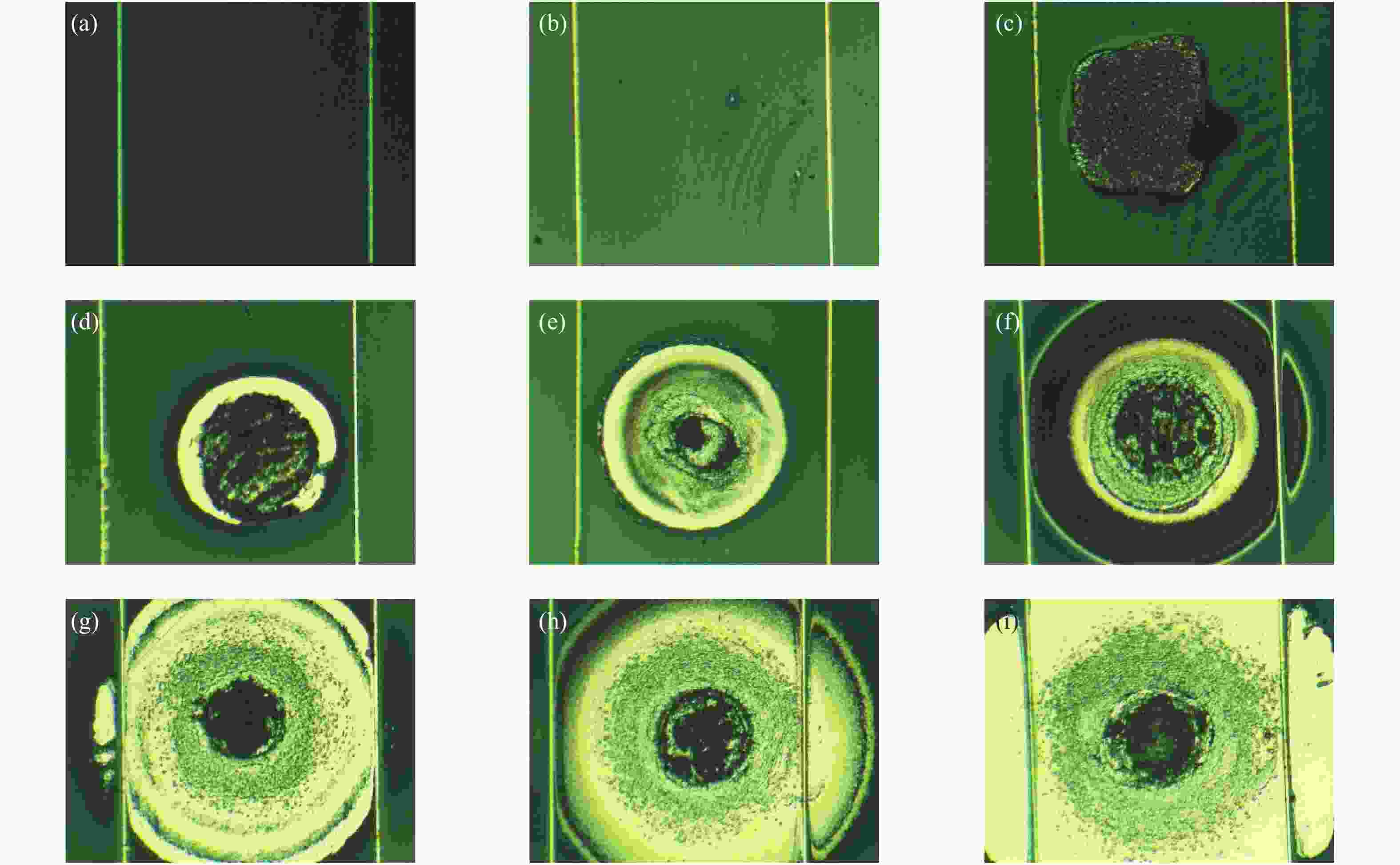
Figure 4. Morphology changes of the non-gate line part of the triple junction GaInP2/GaAs/Ge cell irradiated by nanosecond laser. (a) Original shape of the cell; (b)-(i) Morphology changes by laser irradiation when laser energy density is 3.3, 9.2, 19.4, 33.6, 66.5, 105.5, 129.5, 163.5 J·cm−2 respectively
在正向偏置电压3 V的条件下,使用电致发光检测相机,拍摄不同激光能量密度辐照后三结GaInP2/GaAs/Ge电池的电致发光情况,获得电池内部损伤情况,如图5所示。利用太阳能电池电致发光的灰度值来表示电池在不同损伤程度后的发光情况,进而来判断太阳能电池的损伤特性,图中横坐标为电致发光灰度图的灰度值,纵坐标为灰度值在图像中出现的次数,右上角为太阳能电池电致发光图像。当太阳能电池未受到损伤时,电池的发光强度最高,当电池受到损伤后,发光强度降低,灰度值分布会向左移动。

Figure 5. Electroluminescence changes of the non-gate line part of the triple junction GaInP2/GaAs/Ge cell irradiated by nanosecond laser. (a) Electroluminescence results with no laser ablation; (b)-(h) Electroluminescence results by laser irradiation when laser energy density is 3.3, 19.4, 33.6, 66.5, 105.5, 129.5, 163.5 J·cm−2 respectively
通过对电致发光结果的分析可以发现:电池的发光强度随着激光能量密度的升高而降低,电致发光图像可以观测到电池的损伤影响区,激光能量密度较低时的损伤影响区域主要分布在激光辐照部位周围,随着激光能量密度的升高,影响区范围逐渐增大,直到扩散到整个电池。电致发光图像结果表明,尽管激光烧蚀的是电池表面一小块区域,但是太阳能电池较大范围内都会受到损伤影响。
为了量化比较激光辐照过后电池的电致发光强度变化,将同一张电致发光图中每个像素点的灰度值累加求和,得到相对发光强度,对比不同能量密度激光辐照后电池电致发光的相对发光强度。不同能量密度纳秒激光辐照三结GaInP2/GaAs/Ge电池非栅线部位后,电池的电致发光相对发光强度如图6所示。可以发现,太阳能电池的相对发光强度随着激光能量密度的升高先快速下降,随后下降速度变缓。通过对比太阳能电池的电性能变化可以发现,该趋势与电池的最大功率变化趋势相同。因此,电致发光图像检测可以在一定程度上反映电性能输出的变化趋势。
-
图7、图8分别为激光辐照三结GaInP2/GaAs/Ge电池栅线后的伏安特性和功率电压关系图,可以看出,激光能量密度较低时,脉冲激光辐照很难影响电池电性能,但一旦超过3.3 J/cm2,电池电性能急剧下降。
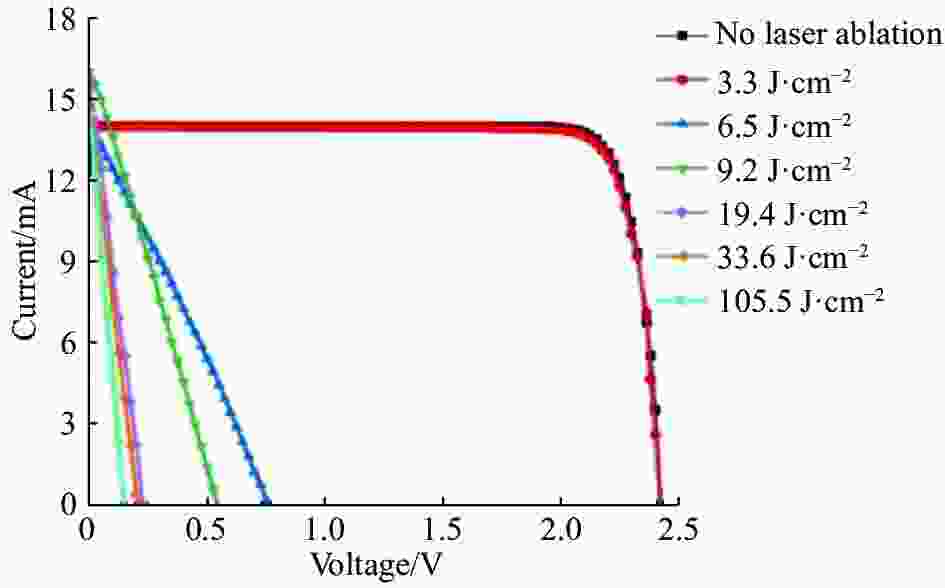
Figure 7. Variation curves of voltage-current characteristics of the gate line part of a triple-junction GaInP2/GaAs/Ge cell irradiated by laser
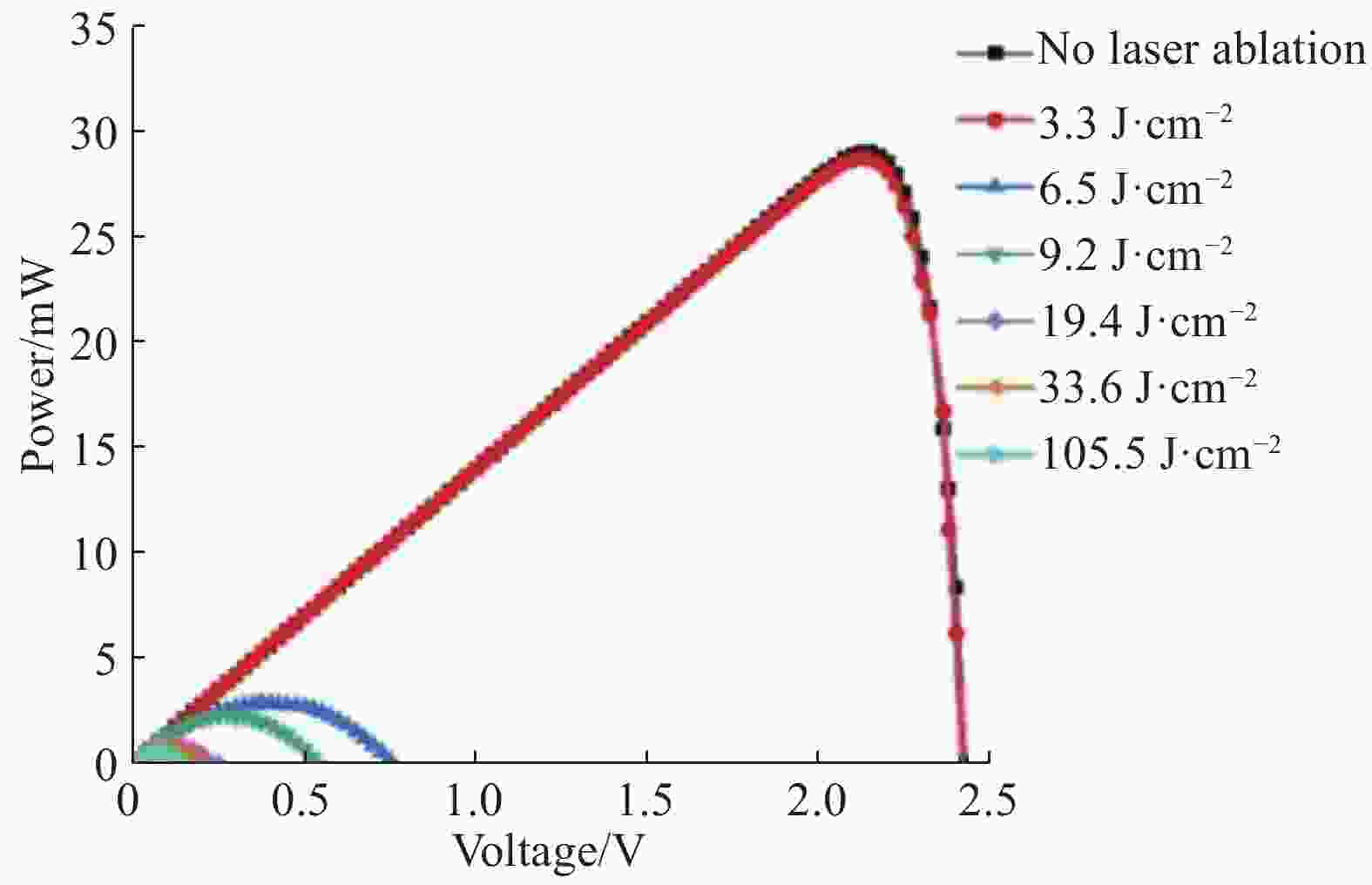
Figure 8. Variation curves of power-voltage characteristics of the gate line part of a triple-junction GaInP2/GaAs/Ge cell irradiated by laser
不同能量密度激光辐照栅线电极后电池的表面形貌如图9所示,可以发现,能量密度3.3 J/cm2的激光辐照后,太阳能电池表面产生轻微烧蚀变化,但未产生明显损伤。进一步提高激光能量密度到6.5 J/cm2后,太阳能电池表面栅线附近出现轻微损伤。随着激光能量密度的提高,激光辐照导致的栅线处烧蚀坑越来越大,并且由于材料熔融再凝固以及由于热扩散作用导致周围区域温度低于材料熔点而发生的氧化还原反应,共同形成了周边环状区域,激光能量密度越高,对应烧蚀形成的环状区域越大。

Figure 9. Morphology changes of the gate line part of the triple junction GaInP2/GaAs/Ge cell irradiated by nanosecond laser with different laser energy densities
不同能量密度激光辐照三结GaInP2/GaAs/Ge电池栅线后,电池的电致发光情况如图10所示,能量密度3.3 J/cm2激光辐照后,电致发光未产生明显变化,与电性能未明显变化相对应;激光能量密度提高到6.5 J/cm2后,电致发光图如图10(c)所示,此时太阳能电池失去电致发光能力,表现为直方图整体左移到最左端,对应电性能变化表现为最大功率产生急剧下降。进一步提高激光能量密度后太阳能电池的电致发光图像反映的结果依然表现为灰度值极低,显然,此时电致发光结果表现为损伤达到饱和。
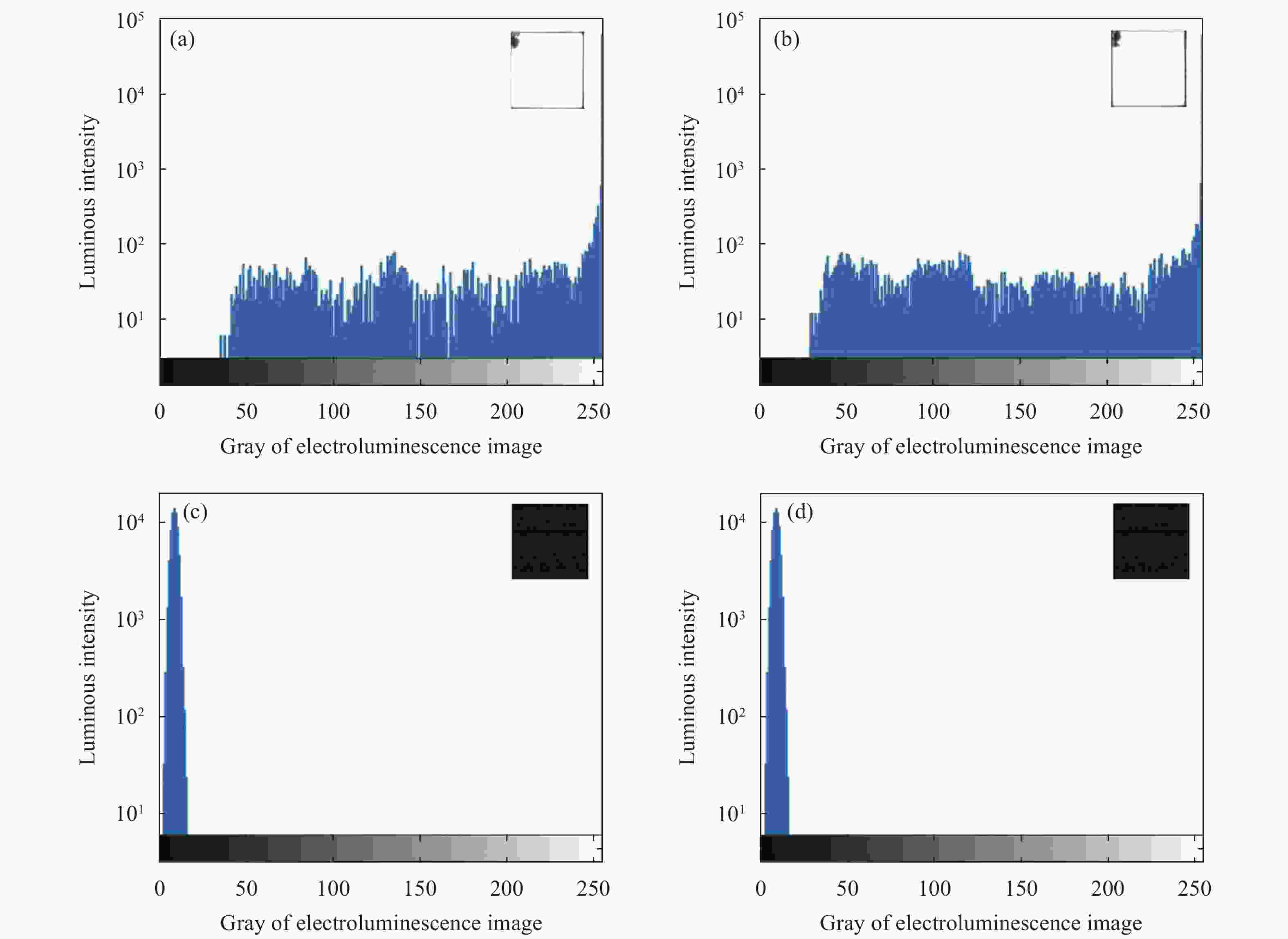
Figure 10. Electroluminescence changes of the gate line part of the triple junction GaInP2/GaAs/Ge cell irradiated by nanosecond laser. (a) Electroluminescence results with no laser ablation; (b)-(d) Electroluminescence results by laser irradiation when laser energy density is 3.3, 6.5, 105.5 J·cm−2 respectively
不同激光能量密度辐照后电池的电致发光相对强度变化结果如图11所示,发光强度随激光能量密度的变化较为敏感,实验中能量密度达到6.5 J/cm2时,激光辐照后电池近乎失去电致发光能力,电致发光的下降规律与最大输出功率下降规律类似。
-
当激光辐照三结GaInP2/GaAs/Ge电池表面非栅线部位时,由于波长1064 nm激光的光子能量小于顶电池GaInP2和中电池GaAs的禁带宽度,无法产生光电响应,大部分光子能量穿过GaInP2和GaAs,由Ge吸收光子能量产生光电响应,Ge材料中的电子吸收光子能量后将产生跃迁,形成光生载流子,载流子吸收激光能量后与晶格耦合,晶格温度升高,最终激光能量以热的形式被Ge吸收,热损伤首先产生于Ge底电池表面,由于激光峰值功率密度高,激光能量短时间内在材料内部沉积,电池局部温度快速升高,在热传导机制下,电池不同层材料的有序掺杂被破坏掉,导致了电池性能的下降;并且Ge电池和GaInP2电池对于温度的升高极为敏感[14],激光辐照导致的温度升高对GaInP2电池和Ge电池产生的损伤更强,降低这两结子电池对三结GaInP2/GaAs/Ge电池电性能输出的贡献,使得电性能产生下降。当激光辐照部位聚焦于三结GaInP2/GaAs/Ge电池栅线时,由于栅线电极的主要作用是用于光生载流子的收集[15],当激光能量密度较高时会导致栅线熔融,一旦栅线电极熔断会降低太阳能电池对于载流子的收集效率,同时电池内部由于激光能量沉积引发温度升高导致损伤产生,使得激光辐照栅线部位损伤效果强于辐照非栅线部位。
-
当纳秒脉冲激光辐照电池非栅线部位时,电池具有较好的抗损伤能力。表面形貌测量表明,光斑辐照中心形成明显烧蚀坑,且烧蚀坑周围存在热扩散影响造成的环状区域,激光能量密度越大,环状区域越大。电池电致发光图像表明,电池内部损伤面积随着激光能量的增加而增大,电致发光强度下降趋势与电池最大功率下降趋势基本相同。
当激光辐照电池栅线部位时,损伤效果强于辐照非栅线部位,激光能量密度19.4 J/cm2辐照后电池便几乎完全损伤。主要由于栅线电极受到激光辐照熔断所致,栅线电极主要用于收集光生载流子,熔断后电池光电转换能力显著下降。表面形貌测量显示,激光辐照后电池栅线被熔断,且形成烧蚀损伤区域。电池电致发光图像显示,电池电性能大幅度下降后失去电致发光能力,电致发光强度的下降规律与最大输出功率降趋势基本相同。
Damage characteristics of the solar cells irradiated by nanosecond pulsed lasers and the effects on photoelectric conversion
doi: 10.3788/IRLA20210296
- Received Date: 2021-05-08
- Rev Recd Date: 2021-06-25
- Publish Date: 2021-11-02
-
Key words:
- laser damage /
- solar cell /
- voltage-current characteristic /
- surface morphology /
- electroluminescence image
Abstract: Damage characteristics of triple-junction GaAs solar cells irradiated by nanosecond pulsed lasers and their effects on photoelectric conversion were studied. The experimental system was established including damage morphology, voltage-current characteristics, and electroluminescence. The gradual decline characteristics of the photovoltaic performance of the cell was analyzed from the material ablation morphology, electrical performance output, and internal damage. On the basis of analyzing the influences of laser energy density, the influence of laser irradiation regions, such as the grid line part and non-grid line part of the cell, was further analyzed. Nanosecond pulsed lasers can cause obvious damage to the cell due to its high peak power. The damage effect of the grid line part of the laser was stronger than that of the non-grid line part, mainly because the function of the grid line electrode was used to collect photo-generated carrier. When the laser radiation fused the cell grid lines, which was used to collect photogenerated carriers, the output power of the cell was reduced. The research conclusions are of great significance for improving the protection capability of the solar cells.









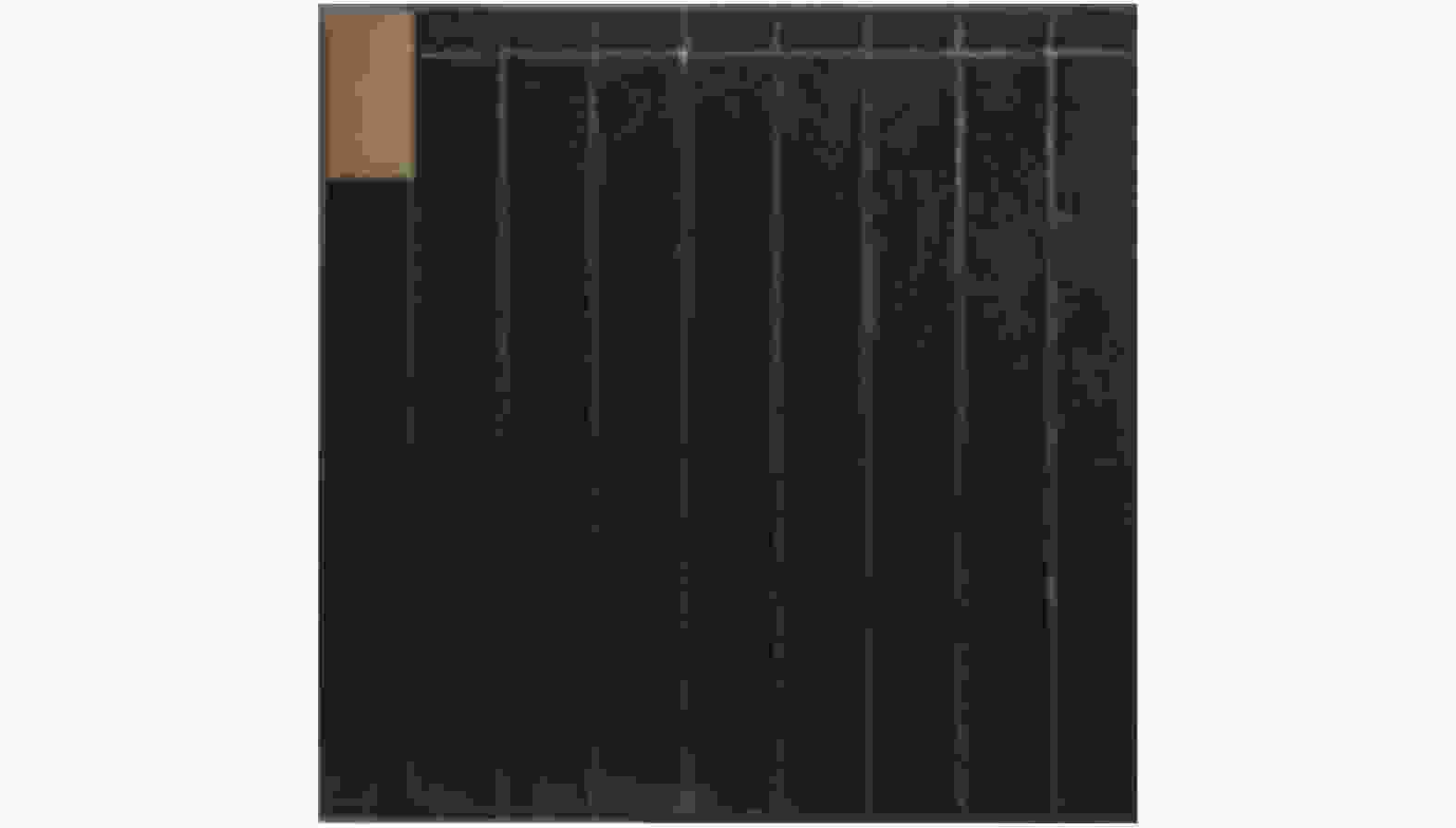

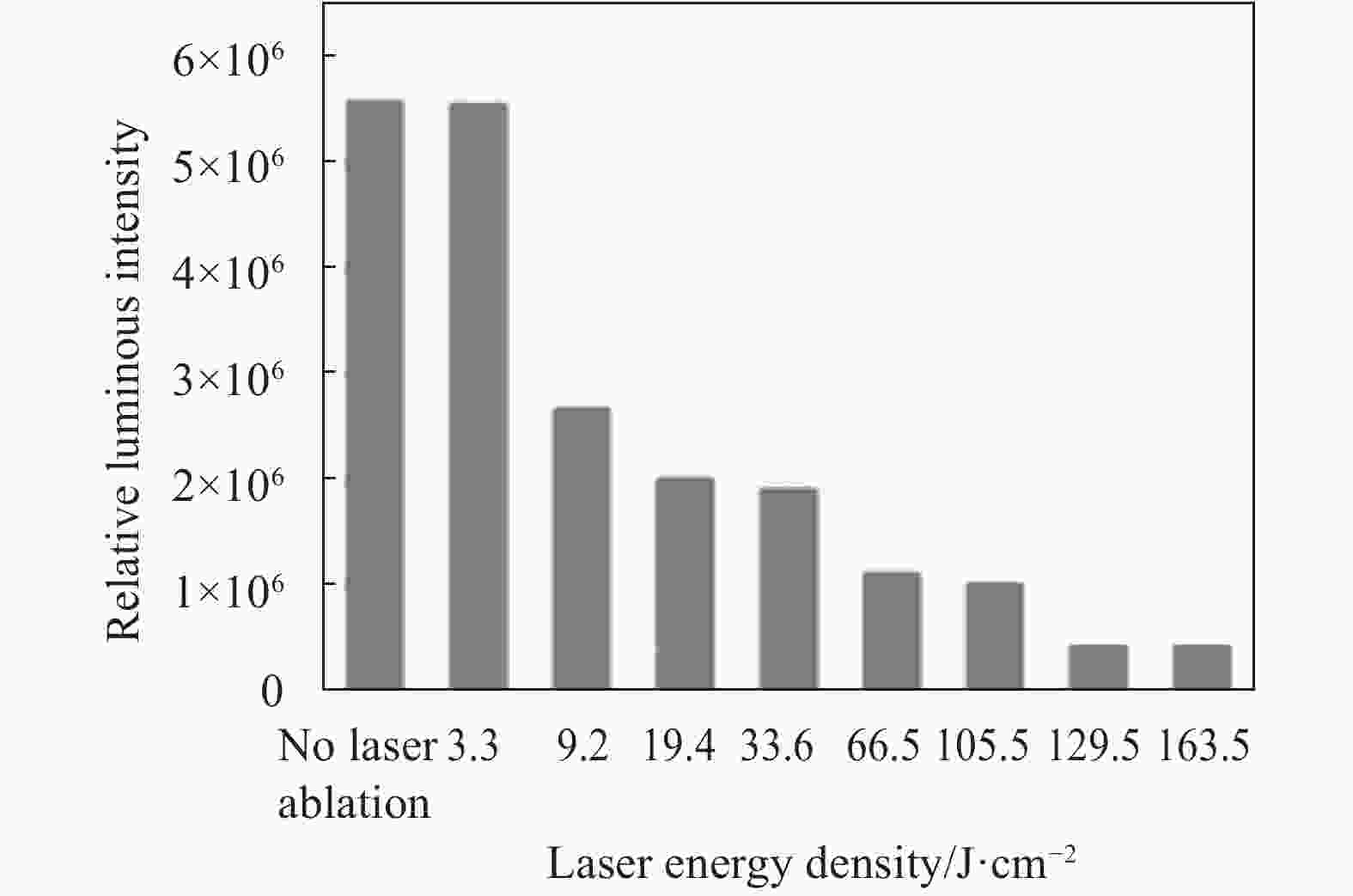
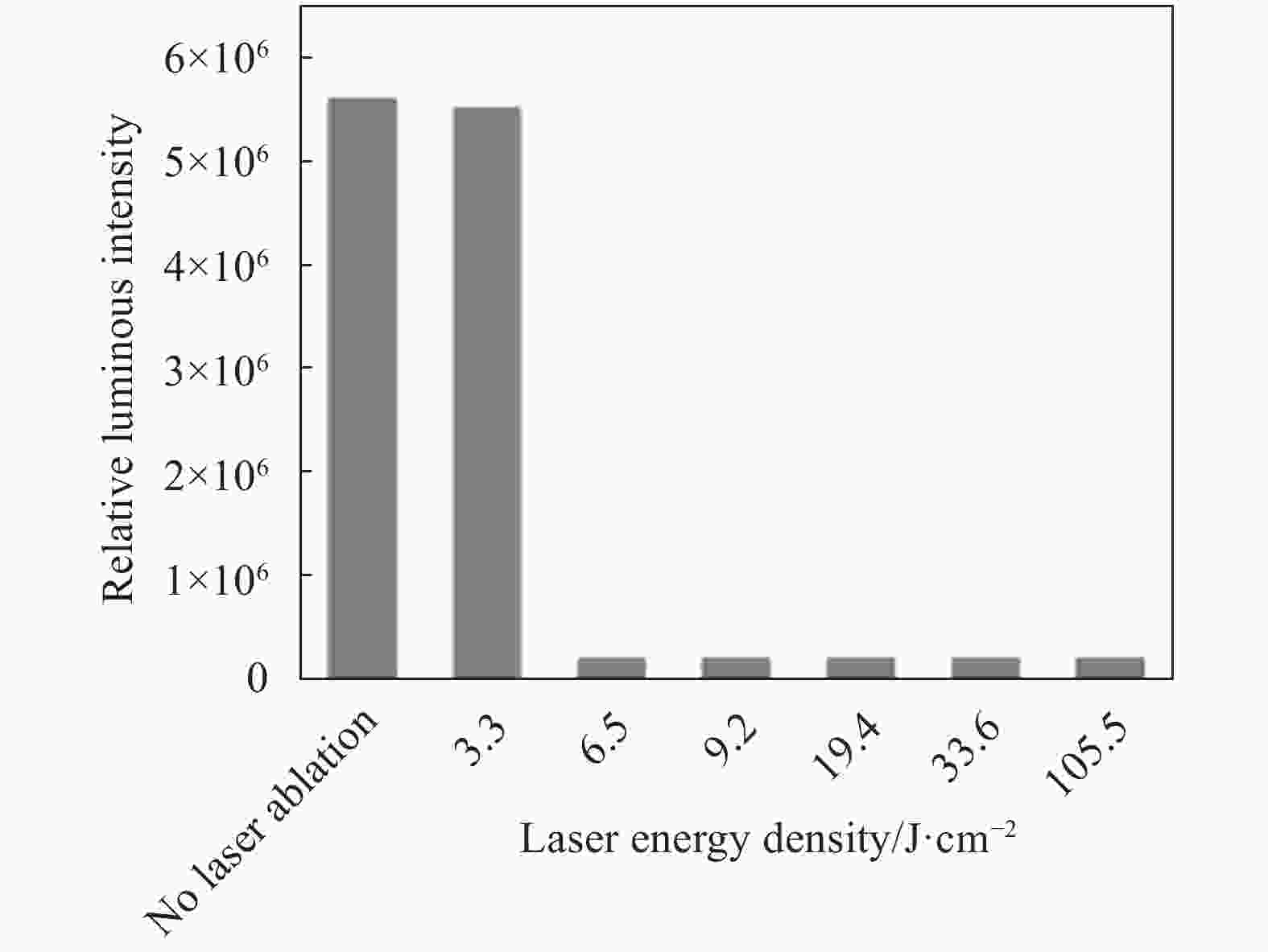

 DownLoad:
DownLoad:
